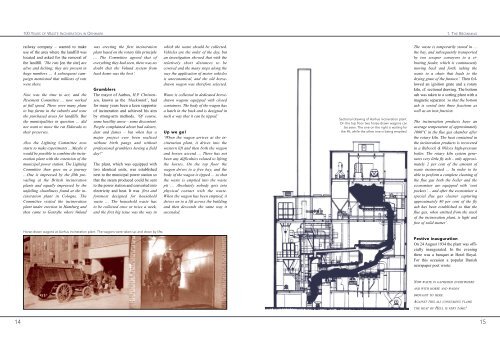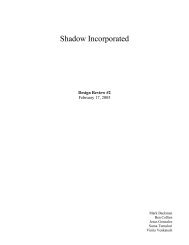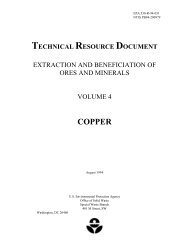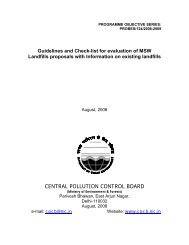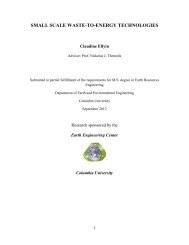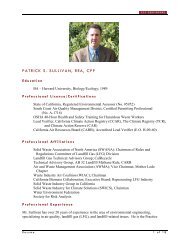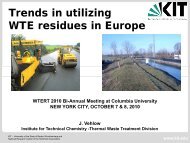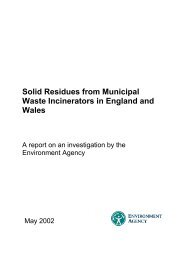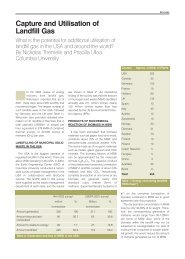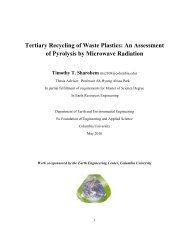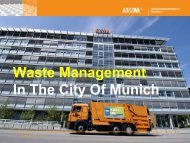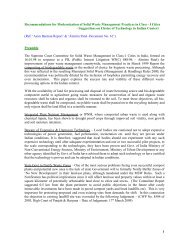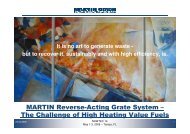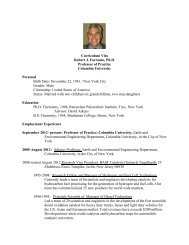100 YEARS OF WASTE INCINERATION IN DENMARK
100 YEARS OF WASTE INCINERATION IN DENMARK
100 YEARS OF WASTE INCINERATION IN DENMARK
You also want an ePaper? Increase the reach of your titles
YUMPU automatically turns print PDFs into web optimized ePapers that Google loves.
<strong>100</strong> <strong>YEARS</strong> <strong>OF</strong> <strong>WASTE</strong> <strong><strong>IN</strong>C<strong>IN</strong>ERATION</strong> <strong>IN</strong> <strong>DENMARK</strong> 1. THE BEG<strong>IN</strong>N<strong>IN</strong>G<br />
railway company – wanted to make<br />
use of the area where the landfill was<br />
located and asked for the removal of<br />
the landfill. ‘The rats [on the site] are<br />
alive and kicking; they are present in<br />
huge numbers … A subsequent campaign<br />
mentioned that millions of rats<br />
were there.<br />
Now was the time to act, and the<br />
Pavement Committee … now worked<br />
at full speed. There were many plans<br />
to buy farms in the suburbs and zone<br />
the purchased areas for landfills. But<br />
the municipalities in question … did<br />
not want to move the rat Eldorado to<br />
their preserves.<br />
Also the Lighting Committee now<br />
starts to make experiments …Maybe it<br />
would be possible to combine the incineration<br />
plant with the extension of the<br />
municipal power station. The Lighting<br />
Committee then goes on a journey<br />
…One is impressed by the filth prevailing<br />
at the British incineration<br />
plants and equally impressed by the<br />
unfailing cleanliness found at the incineration<br />
plant in Cologne. The<br />
Committee visited the incineration<br />
plant under erection in Hamburg and<br />
then came to Gentofte where Vølund<br />
was erecting the first incineration<br />
plant based on the rotary kiln principle<br />
… The Committee agreed that of<br />
everything they had seen, there was no<br />
doubt that the Vølund system from<br />
back home was the best’.<br />
Grumblers<br />
The mayor of Aarhus, H.P. Christensen,<br />
known as the ‘blacksmith’, had<br />
for many years been a keen supporter<br />
of incineration and achieved his aim<br />
by strong-arm methods. ‘Of course,<br />
some hostility arose – some discontent.<br />
People complained about bad odours,<br />
dust and fumes – but when has a<br />
major project ever been realised<br />
without birth pangs and without<br />
professional grumblers having a field<br />
day’<br />
The plant, which was equipped with<br />
two identical units, was established<br />
next to the municipal power station so<br />
that the steam produced could be sent<br />
to the power station and converted into<br />
electricity and heat. It was ‘first and<br />
foremost designed for household<br />
waste … The household waste has<br />
to be collected once or twice a week,<br />
and the first big issue was the way in<br />
which the waste should be collected.<br />
Vehicles are the order of the day, but<br />
an investigation showed that with the<br />
relatively short distances to be<br />
covered and the many stops along the<br />
way the application of motor vehicles<br />
is uneconomical, and the old horsedrawn<br />
wagon was therefore selected.<br />
Waste is collected in dedicated horsedrawn<br />
wagons equipped with closed<br />
containers. The body of the wagon has<br />
a hatch in the back and is designed in<br />
such a way that it can be tipped.’<br />
Up we go!<br />
‘When the wagon arrives at the incineration<br />
plant, it drives into the<br />
western lift and then both the wagon<br />
and horses ascend … There has not<br />
been any difficulties related to lifting<br />
the horses. On the top floor the<br />
wagon drives to a free bay, and the<br />
body of the wagon is tipped … so that<br />
the waste is emptied into the waste<br />
pit … Absolutely nobody gets into<br />
physical contact with the waste.<br />
When the wagon has been emptied, it<br />
drives on to a lift across the building<br />
and then descends the same way it<br />
ascended.<br />
Sectional drawing of Aarhus incineration plant.<br />
On the top floor two horse-drawn wagons can<br />
be seen. The one on the right is waiting for<br />
the lift, while the other one is being emptied.<br />
The waste is temporarily stored in …<br />
the bay, and subsequently transported<br />
by two scraper conveyors to a vibrating<br />
feeder, which is continuously<br />
moving back and forth, taking the<br />
waste to a chute that leads to the<br />
drying grate of the furnace’. Then followed<br />
an ignition grate and a rotary<br />
kiln, cf. sectional drawing. The bottom<br />
ash was taken to a sorting plant with a<br />
magnetic separator ‘so that the bottom<br />
ash is sorted into three fractions as<br />
well as an iron fraction.<br />
The incineration products have an<br />
average temperature of approximately<br />
<strong>100</strong>0°C in the flue gas chamber after<br />
the rotary kiln. The heat contained in<br />
the incineration products is recovered<br />
in a Babcock & Wilcox high-pressure<br />
boiler. The rotary kiln system generates<br />
very little fly ash – only approximately<br />
2 per cent of the amount of<br />
waste incinerated … In order to be<br />
able to perform a complete cleaning of<br />
the flue gas both the boiler and the<br />
economiser are equipped with ‘soot<br />
pockets’… and after the economiser a<br />
special flue gas cleaner capturing<br />
approximately 80 per cent of the fly<br />
ash has been established so that the<br />
flue gas, when emitted from the stack<br />
of the incineration plant, is light and<br />
free of solid matter’.<br />
Horse-drawn wagons at Aarhus incineration plant. The wagons were taken up and down by lifts.<br />
Festive inauguration<br />
On 24 August 1934 the plant was officially<br />
inaugurated. In the evening<br />
there was a banquet at Hotel Royal.<br />
For this occasion a popular Danish<br />
newspaper poet wrote:<br />
NOW <strong>WASTE</strong> IS GATHERED EVERYWHERE<br />
AND WITH HORSE AND WAGON<br />
BROUGHT TO HERE.<br />
AGA<strong>IN</strong>ST THIS ALL CONSUM<strong>IN</strong>G FLAME<br />
THE HEAT <strong>OF</strong> HELL IS VERY TAME!<br />
14 15


